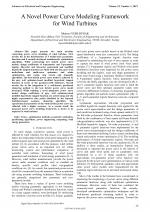| 3/2019 - 4 |
A Novel Power Curve Modeling Framework for Wind TurbinesYESILBUDAK, M. |
| View the paper record and citations in |
| Click to see author's profile in |
| Download PDF |
Author keywords
optimization methods, parameter estimation, partitioning algorithms, power engineering computing, wind energy generation
References keywords
wind(22), power(20), energy(17), curve(13), turbine(11), renewable(7), algorithm(6), systems(5), optimization(5), modeling(5)
Blue keywords are present in both the references section and the paper title.
About this article
Date of Publication: 2019-08-31
Volume 19, Issue 3, Year 2019, On page(s): 29 - 40
ISSN: 1582-7445, e-ISSN: 1844-7600
Digital Object Identifier: 10.4316/AECE.2019.03004
Web of Science Accession Number: 000486574100004
SCOPUS ID: 85072171926
Abstract
This paper presents two main novelties concerning power curve modeling of wind turbines. First novelty lies in the hybridization of 5 widely-used parametric functions and 8 recently-developed metaheuristic optimization algorithms. While constructing new hybrid power curve models, design coefficients of 4-parameter and 5-parameter logistic, 5th-order and 6th-order polynomial and modified hyperbolic tangent functions are fitted with ant lion, grey wolf, moth-flame and multi-verse optimizers and whale optimization, sine cosine, salp swarm and dragonfly algorithms. The best hybrid power curve model is achieved by the grey wolf optimizer-based modified hyperbolic tangent function in terms of the goodness-of-fit indicators. Second novelty lies in the integration of a well-known partitional clustering method to the best hybrid power curve model developed. While building a novel integrative power curve model, design coefficients of grey wolf optimizer-based modified hyperbolic tangent function are solved using only the highly representative data points identified by the Squared Euclidean-based k-means clustering algorithm. The operational characteristics of the wind turbine power curve are reflected with a higher accuracy. As a crucial result, the proposed power curve modeling framework is shown to be superior for wind turbines. |
| References | | | Cited By |
Web of Science® Times Cited: 3 [View]
View record in Web of Science® [View]
View Related Records® [View]
Updated today
SCOPUS® Times Cited: 5
View record in SCOPUS® [Free preview]
View citations in SCOPUS® [Free preview]
[1] A Novel Power Curve Prediction Method for Horizontal-Axis Wind Turbines Using Artificial Neural Networks, Cent Tai, Vin, Chai Tan, Yong, Faiza Abd Rahman, Nor, Ming Chia, Chee, Zhakiya, Mirzhakyp, Huat Saw, Lip, Energy Engineering, ISSN 0199-8595, Issue 3, Volume 118, 2021.
Digital Object Identifier: 10.32604/EE.2021.014868 [CrossRef]
[2] Adjustable piecewise regression strategy based wind turbine power forecasting for probabilistic condition monitoring, Jing, Hua, Zhao, Chunhui, Sustainable Energy Technologies and Assessments, ISSN 2213-1388, Issue , 2022.
Digital Object Identifier: 10.1016/j.seta.2022.102013 [CrossRef]
[3] A Review on Wind Turbine Deterministic Power Curve Models, Villanueva, Daniel, Feijóo, Andrés, Applied Sciences, ISSN 2076-3417, Issue 12, Volume 10, 2020.
Digital Object Identifier: 10.3390/app10124186 [CrossRef]
[4] Comparison of Outlier Detection Approaches for Wind Turbine Power Curves, Oflaz, Abdullah Emin, Yesilbudak, Mehmet, 2022 10th International Conference on Smart Grid (icSmartGrid), ISBN 978-1-6654-8604-0, 2022.
Digital Object Identifier: 10.1109/icSmartGrid55722.2022.9848698 [CrossRef]
Disclaimer: All information displayed above was retrieved by using remote connections to respective databases. For the best user experience, we update all data by using background processes, and use caches in order to reduce the load on the servers we retrieve the information from. As we have no control on the availability of the database servers and sometimes the Internet connectivity may be affected, we do not guarantee the information is correct or complete. For the most accurate data, please always consult the database sites directly. Some external links require authentication or an institutional subscription.
Web of Science® is a registered trademark of Clarivate Analytics, Scopus® is a registered trademark of Elsevier B.V., other product names, company names, brand names, trademarks and logos are the property of their respective owners.
Faculty of Electrical Engineering and Computer Science
Stefan cel Mare University of Suceava, Romania
All rights reserved: Advances in Electrical and Computer Engineering is a registered trademark of the Stefan cel Mare University of Suceava. No part of this publication may be reproduced, stored in a retrieval system, photocopied, recorded or archived, without the written permission from the Editor. When authors submit their papers for publication, they agree that the copyright for their article be transferred to the Faculty of Electrical Engineering and Computer Science, Stefan cel Mare University of Suceava, Romania, if and only if the articles are accepted for publication. The copyright covers the exclusive rights to reproduce and distribute the article, including reprints and translations.
Permission for other use: The copyright owner's consent does not extend to copying for general distribution, for promotion, for creating new works, or for resale. Specific written permission must be obtained from the Editor for such copying. Direct linking to files hosted on this website is strictly prohibited.
Disclaimer: Whilst every effort is made by the publishers and editorial board to see that no inaccurate or misleading data, opinions or statements appear in this journal, they wish to make it clear that all information and opinions formulated in the articles, as well as linguistic accuracy, are the sole responsibility of the author.





